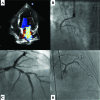Successful extracorporeal membrane oxygenation assisted revascularisation in a high-risk elderly patient refused surgical treatment
- PMID: 32355458
- PMCID: PMC7180410
- DOI: 10.6001/actamedica.v26i4.4205
Successful extracorporeal membrane oxygenation assisted revascularisation in a high-risk elderly patient refused surgical treatment
Abstract
Management of high-risk elderly patients requiring revascularisation remains a clinical challenge. We report a case of extracorporeal membrane oxygenation (ECMO) assisted complex percutaneous coronary intervention in a high-risk octogenarian. An 83-year-old female with signs of worsening heart failure was admitted to the emergency department of a tertiary care facility. Transthoracic echocardiography revealed a decreased left ventricular ejection fraction of 20% with severe mitral regurgitation and mild aortic and tricuspid valve insufficiency. Three-vessel disease was found during coronary angiography. Due to the patient's frailty, a high-risk surgery decision to proceed with ECMO assisted percutaneous coronary intervention was made during a heart team meeting. Following initiation of mechanical support, coronary lesions were treated with three drug-eluting stents. After the procedure, the patient was transferred to the ICU on ECMO support, where she was successfully weaned from the device 9 h later. Her ICU stay was four days. She was successfully discharged from the hospital after uneventful recovery. At one-year's follow-up, the patient was clinically stable in an overall state of general well-being and with complete participation in routine activities; she had good exercise tolerance and no signs of ischemia. This report highlights the possibility of use of ECMO during PCI in high-risk elderly patients.
Santrauka Vyresnio amžiaus didelės rizikos pacientų grupėje miokardo revaskuliarizacija išlieka klinikiniu iššūkiu. Pristatomas klinikinis atvejis, kai kompleksinė perkutaninė koronarinė intervencija buvo įmanoma tik naudojant ektrakorporinę membraninę oksigenaciją (EKMO). 83 metų pacientė hospitalizuota į tretinio lygio ligoninę dėl progresuojančio širdies nepakankamumo. Atlikus širdies ultragarso tyrimą nustatyta itin sumažėjusi kairiojo skilvelio išstūmimo frakcija (20 %) ir didelis mitralinio vožtuvo nesandarumas, vidutiniai aortos ir triburio vožtuvų nepakankamumai. Atlikus koronarografiją nustatyta trijų vainikinių arterijų liga. Dėl labai didelės operacinio gydymo rizikos buvo nuspręsta atlikti perkutaninę koronarinę intervenciją taikant EKMO. Pasitelkus pagalbinę mechaninę kraujotaką buvo atliktas trijų vainikinių arterijų stentavimas. Po procedūros pacientė buvo pervežta į intensyviosios terapijos skyrių taikant EKMO, po devynių valandų pagalbinė kraujotaka buvo sėkmingai atjungta. Intensyviosios terapijos skyriuje pacientė buvo gydoma keturias paras. Praėjus vieneriems metams ji jautėsi gerai, toleravo vidutinio sunkumo fizinį krūvį ir kasdienės veiklos apribojimų nejuto.Šis klinikinis atvejis parodo veiksmingą EKMO taikymą atliekant sudėtingas perkutanines koronarines intervencijas.Raktažodžiai: EKMO, perkutaninė koronarinė intervencija, koronarinė širdies liga, vyresnio amžiaus pacientas.
Keywords: ECMO; coronary artery disease; elderly patient; percutaneous coronary intervention.
© Lietuvos mokslų akademija, 2020.
Figures

References
-
- Neumann F Sousa-Uva M Ahlsson A Alfonso F Banning A Benedetto U et al. .. 2018 ESC/EACTS guidelines on myocardial revascularization. Eur Heart J. 2019; 40: 87–165. doi:10.1093/eurheartj/ehy394. - DOI - PubMed
-
- Karagiannidis C Brodie D Strassman S Stoelben E Philipp A Bein T et al. .. Extracorporeal membrane oxygenation: evolving epidemiology and mortality. Intensive Care Med. 2016; 42: 889–896. doi:10.1007/s00134-016-4273-z. - DOI - PubMed
-
- Mourad M Gaudar P De La Arena P Eliet J Zeroural N Rouviere P et al. .. Circulatory support with extracorporeal membrane oxygenation and/or impella for cardiogenic shock during myocardial infarction. ASAIO J. 2018; 64(6): 708–14. doi:10.1097/MAT.0000000000000704. - DOI - PubMed
-
- D’Agostino R Jacobs J Badhwar B Fernandez FG Paone G Wormuth DW et al. . . The Society of Thoracic Surgeons Adult Cardiac Surgery database: 2018 update on outcomes and quality. Ann Thorac Surg. 2018; 105: 15–23. doi:10.1016/j.athoracsur.2017.10.035. - DOI - PubMed
-
- Acker M Parides M Perrault L Moskowitz AJ Gelijns AC Voisine P et al. . . Mitral valve repair versus replacement for severe ischemic mitral regurgitation. N Engl J Med. 2014; 370: 23–32. doi:10.1056/NEJMoa1312808. - DOI - PMC - PubMed
LinkOut - more resources
Full Text Sources
Miscellaneous
